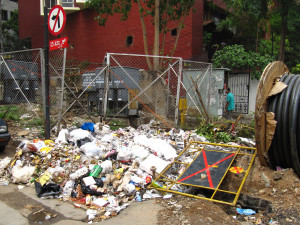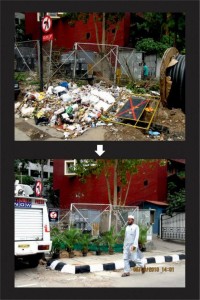Under the light of a pen-torch, they peer closely at the photograph of the same spot they took that morning.
Ugh!

This is the corner of Church Street and Rest House Road, right outside the entrance to the offices of Wipro & Times of India. Church Street is Bengaluru’s most happening street, packed with pubs, restaurants, cafes and bookstores, and always full of people having a good time. If you had to pick one street that symbolized Bangalore, it would have to be Church Street on a weekend.
But there is a dark side to Church Street – ugly spots like this one. This ugly mess is a symbol of what is going wrong in Bangalore. Well, in India. It’s October 2010, Bangalore is India’s boomtown and the global tech capital, and its proud citizens have seemingly done a lot of things right. Over a million migrants have moved to this city in a decade seeking world-class jobs and a better life, and global companies have flocked here to set up shop, recruit people, outsource services. Yet, right outside major company offices, on busy important streets, in the heart of the city and in plain view of everyone, are ugly ‘spots’ like this that nobody seems to be able to get rid of.
This is by no means the only one – there are many more, every fifty metres or so. It just isn’t right. It seems that everyone wants to get rid of these eyesores, but nobody seems to know what to do. Or if they did, nobody is doing anything about it. It shouldn’t be that difficult to keep a street clean, especially the important streets in the centre of a city that is positioned as the poster-child of 21st century India. Apparently, it is.
The media is screaming out loud, the government is making promises, activists are crying foul, industry says the ‘Bangalore story’ is over and it’s time to look at other cities. Everyone seems to be worked up about the civic mess – on TV talk shows, in the press, in coffee-machine conversations. But on the ground – there is no action. This particular Ugly Spot has survived merrily for decades, least affected by all the hot air and indignation being generated at the media offices that surround it. (Most major national newspapers have their Bangalore Head Offices within sniffing distance of this dump).
Agents V & X have decided to act. They are sick of waiting for someone else to do it for them. All the big talk of being a global city and all that is meaningless, if something like this can be allowed to happen right under your noses. And they have picked this Spot as a symbol of all that is wrong. If they can reverse this civic disaster trend here, at this spot, they surmise, there is hope.
They wonder, why exactly is there a garbage dump here? Why don’t the big companies located nearby fix this? Whom should they ask? How do you even begin to find out these things? They are regular citizens and have no idea how the systems work. They decide to ‘sit quietly and watch’.
They have spent two days observing the spotat different times of day, and been talking to people who walk by.
Sir, what do you feel about this? … “It has always been like this”… “We cannot recall a time when this corner was clean”….”What to do, this is the sad state of our city”….are common refrains. There is an air of resignation and helplessness.
And who is to blame? On this point, there is amazing clarity – everyone blames someone else – their neighbor, the politicians, the Bangalore civic authority BBMP, or ‘the system’. Some venture more information “workers from pubs and restaurants come at night and dump their garbage here”. Everyone is also clear that it is impossible to fix – ‘you know, we are like that only’, ‘we are dirty people’, ‘our politicians are corrupt’. It’s depressing how helpless and cynical everyone is.
One bearded guy in a kurta tells them –“don’t waste your time, we have tried for years, cleaned it up several times, and the mess simply comes back. The people here are not good – North Indians”, he whispers, with added emphasis. He looks the stereotypical activist – well-meaning at heart, but angry and frustrated with the people and the system.
Agents V & X are not surprised. This is a typical ugly Indian response. When it comes to a common problem in a public space that affects everyone, the Indian immediately blames someone else, discourages those who want to solve it, offers no practical solutions. He looks the other way and gets on with his life. It’s not my job to fix this anyway, he reasons, there are elected representatives for that. And I pay my taxes and I vote – what more should I do?
V & X are sick of these arguments. Asking around hasn’t got them the answer – lots of people have made lots of accusations, many contradictory – clearly, nobody really understands why the problem persists.
They have decided that they want to fix this. They want to see if two common citizens can solve a common civic problem that has defied a solution for years. By using their own time, money and methods, and with no help from anyone. Over the next 72 hours, starting with the ‘hit’ on Friday midnight, a clinical operation is executed undercover. They call it a SpotFix and this is the result on Monday evening 5pm.

Wow! Brilliant! Dozens of comments and hundreds of Likes dot the TUI Facebook page when this Before-After combination picture was posted a few weeks later. A day earlier, the ‘Before’ Picture had been posted as a “Spot Quiz”, where people were asked to guess the location of this Spot.
Interestingly, dozens of Bangaloreans (even those who had left the city years earlier) had correctly identified this as the Times of India corner or the Wipro corner! When regular citizens can identify the precise location of garbage dumps just by looking at them, it tells you that these dumps are part of the sub-conscious, probably used to provide directions, and part of what is considered ‘normal’. Incredible India indeed!
The citizens of the online world are brutal – they only care for instant gratification and real results. So are citizens in the real world. They too only care for results. Anyone who has worked in a position of authority (in government, or a building society, or a Resident Welfare Association) knows how hard it is to satisfy the fickle citizen, who always demands instant visible results to what he considers his pressing civic problems.
V & X know that and have focused all their energies on delivering this dramatic result, this single Before-After image, that is proof of dramatic change. And it has worked – in terms of creating initial positive impact (both on the ground and online). Whether it will survive and change community behavior is another story. But this initial impact is crucial, as we will discover later, in generating respect from the community and the authorities.
But before we get there, let’s trace the fascinating story of how this change was achieved. It was not just an act of cleaning up and applying a dash of cement and paint. In fact, that was the easiest part, the last part, the veritable icing on the cake. Real change takes real work – lots of which is done in the background and out of sight.
This spot remained clean not just for 1 week or 1 month, it is clean at the time of writing 38 months later (Dec 2013) and people have forgotten that it ever was a mess. Those who joined Wipro or Times of India in 2011 would probably not identify the location of the photo on pg 1 – the ugliness has been erased from public memory.
This experiment is the perfect example of how real change can be achieved at the street-level to a seemingly intractable civic problem – and offers a template for others to follow. This initial success had a positive cascading effect on the entire street, dozens of similar spots were ‘fixed’ by a large growing number of anonymous volunteers, and it established the credentials of The Ugly Indian as a group that was serious, committed and would do whatever it takes to achieve their result – a clean street. Yes, the “Times of India SpotFix” had the classic TUI signature.
Of course, many cynics said – this is just 1 spot on 1 street, what good will it do? Others said – this is a band-aid, a stop-gap, a jugaad, and until the entire system changes, such citizen acts, while well-meaning and useful, do not really make a difference to the big picture. Really? It is fascinating how cynics sprout up whenever citizen-driven Spotfixing is attempted on the street. Nobel Laureate Amartya Sen correctly described us as argumentative Indians – we love to talk, offer opinions and give advice, but we just don’t get down to doing.
TUI’s approach to cynics is to ignore them. If people know better, they should go ahead and implement their ideas. And the street, which is the ultimate leveller, will decide the best solution! Ultimately, everyone wants these ugly spots to vanish, so the right answer is the one that works!
It’s now time to unravel the real story behind the Times of India SpotFix. There are lessons here that have been used in innumerable spotfixes across Bangalore, and insights that can be used to fix a host of civic problems that you face on your street. Finally it all boils down to a simple motto – Kaam Chalu Mooh Bandh. Just Work No Talk.
Just think about it – a chronic civic issue in city centre was fixed by a few well-meaning first-time amateurs over a weekend, with their mouths firmly shut. No activism, no cribbing, no lecturing, no awareness drives, no media, no politician-bashing — just silent direct action. And it has worked. Is this for real ? Could it be the beginning of a revolutionary new way of addressing local civic problems? Let’s find out!
Related Articles
The Hit!
Being The Ugly Indian: It’s all about fixing whatever we can